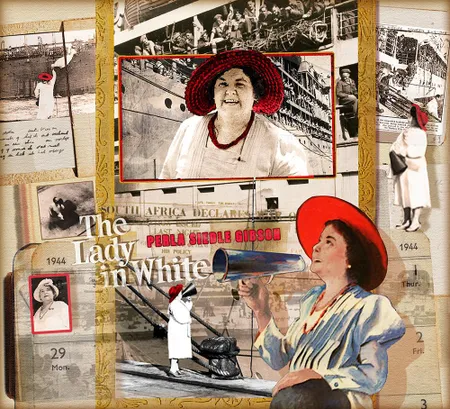FROM her house on a hill in Berea overlooking Durban harbour, she could see the steam of the warships as they slowly came alongside or prepared to depart. She then got into her Buick sedan and drove down to the dock.
There she stood in her signature white dress, red hat and red necklace, a type of uniform which could be recognised from afar. Perla Siedle Gibson, a soprano, then sang at the top of her lungs through her megaphone for the soldiers on these ships.
Her singing lifted the morale of hordes of tired troops. Many of the very young men who longed to go home surely saw a bit of their mothers in her.
It was a bittersweet reminder of their homeland, of better days ahead, a return to a family waiting for them, the hope that the war would one day end. She was in her early 50s when she started and forged an emotional connection with these people from around the world.
She became known as the Lady In White. Time, Life and many other international publications from countries such as India and Canada reported on her. Between April 1940 and August 1945, she sang for more than 5,000 ships and a quarter of a million soldiers.
Lees hierdie artikel in Afrikaans:
Peter Dickens writes on the SA Military History Society website that during World War 2, Durban was a busy port of call for transit ships on their way to and from North Africa and the Far East. For every warship that sailed in or out of the harbour entrance, she was there, standing proudly on the north pier, her rich voice echoing over the water.
She took up her position at dawn or dusk, in wind, rain or burning sun. She never missed a convoy. Not even the one that sailed on the day she learnt her eldest son had been shot dead in skirmishes in Italy.
On November 15 1943, Time wrote that she had a megaphone that allowed her strong Wagnerian voice to travel far over the waters. One soldier recounted: “Gradually the troopship drew away and at the end of the jetty that white-clad figure started Auld Lang Syne. As the gap grew, just snatches of the words came to us, and finally, just a picture of that solitary figure in white waving to us, and we swear she was still singing. We may forget many things of this war, but never the songs of Durban's Lady in White."
She had a large repertoire. For the Americans she sang God Bless America and The Star-Spangled Banner. The British liked There'll Always be an England, the Australians raved about Waltzing Matilda. South Africans wanted to hear Sarie Marais, and the Greeks and Poles were obsessed with operatic arias.
How did it all begin? A young soldier from Ireland stayed the night with Gibson and her family. She made a hearty stew with mutton, potatoes, onions and parsley. Irish food.
They listened to Irish songs together on the wobbly old gramophone. The next day he had to leave.
When his ship left the harbour, he shouted to her to please sing something. And with her hands held as a makeshift speaker at her mouth she sang When Irish Eyes are Smiling. He waved to her until he disappeared over the horizon.
The emotional effect on the young man, the crew members — and on Gibson — was so powerful that she decided she would sing to every warship. Later, soldiers from all over the world started talking about her.
Ships' captains saluted her as their vessels sailed past and the crew waved and whistled. The Czechs and Poles clicked their heels for her and stood to attention.
The South African Military History website continues that she sang even longer for hospital ships and one day for six hours for a British ship. Large parts of Durban could hear as ships came to anchor in the harbour, because the booming voices of the soldiers who sang with her echoed through the streets.
She would start by singing “coo-ee" loudly, to which the soldiers thundered back. Then came the first song, and it was always the same: Land of Hope and Glory.
Magazines such as Life wrote that her emotions were so raw and honest that people could feel them across the water. For her part, she felt as if each soldier was her own child. They sent her letters and souvenirs from places like New York, London, Bombay (Mumbai), Cairo and Singapore.
Later, a statue was erected for her, and when the British singer Vera Lynn visited South Africa after the war she made a point of seeking her out. Lynn was even more famous for the songs she sang to soldiers.
When the war ended, Gibson didn't sit at home and bake cookies. In 1948, when the Nats took power, she actively protested against apartheid and raised her voice.
Perla Siedle Gibson died in 1971 just before her 83rd birthday. It is a shame that we have mostly forgotten about her today.
Perhaps one should be philosophical about oblivion and glamour and turn to the Stoics Society paraphrase of Marcus Aurelius's words: “Life is a procession of people leaving the stage, having their moment and then that moment ends."
♦ VWB ♦
BE PART OF THE CONVERSATION: Go to the bottom of this page to share your opinion. We look forward to hearing from you.







To comment on this article, register (it's fast and free) or log in.
First read Vrye Weekblad's Comment Policy before commenting.